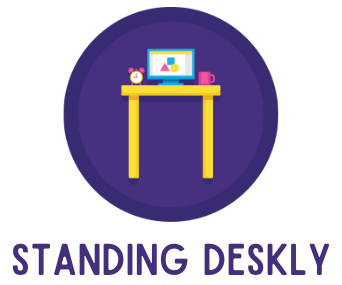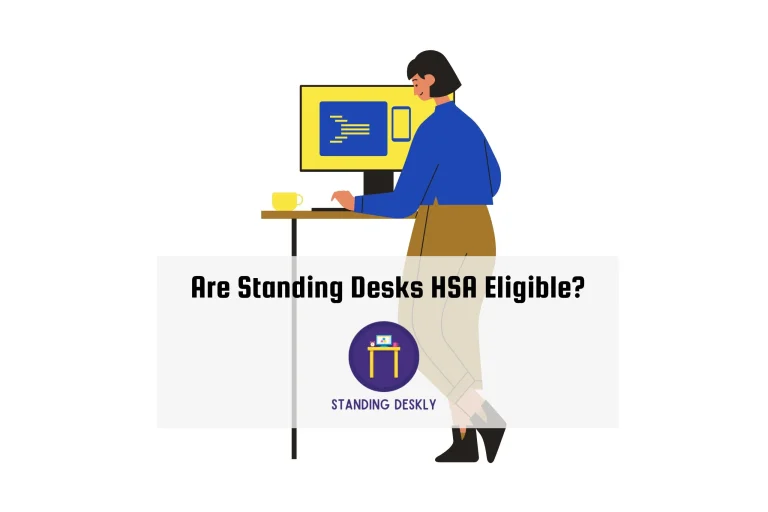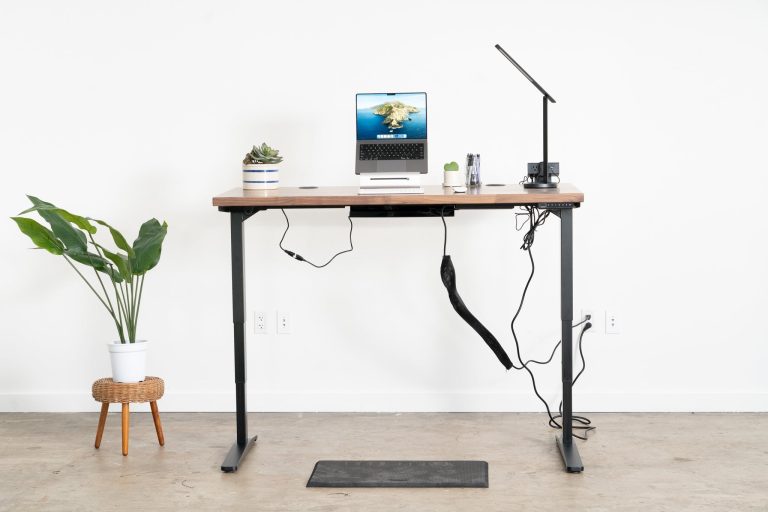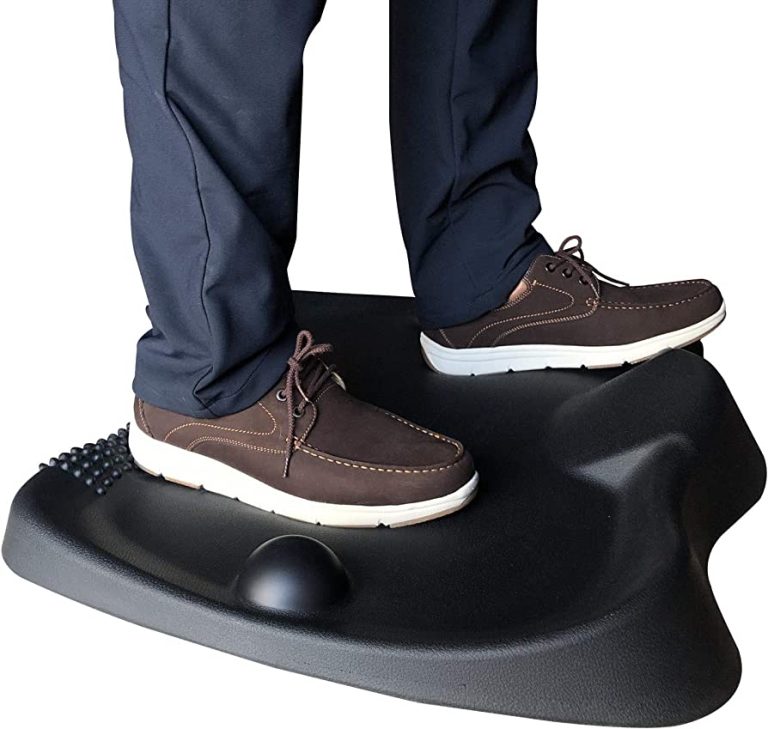Stand Up for Your Health: Transition to a Standing Desk Today!
To transition to a standing desk, start by adjusting the height of your desk and monitor to fit your body’s natural position. Then, stand for short periods and gradually increase the duration over time to prevent discomfort and fatigue.
Using a standing desk has gained popularity in recent years due to its benefits to physical and mental health. Sitting for long periods can increase the risk of cardiovascular diseases, diabetes, and weight gain, and cause neck and back pain.
A standing desk can reduce these risks and help improve posture, burn more calories, and boost energy levels. If you’re new to standing desks, transitioning can be challenging, but with proper adjustments and gradually increasing standing time, it can become a comfortable and healthy work habit. In this article, we’ll explore the steps to transition to a standing desk, tips to stay comfortable, and the benefits of this workspace arrangement.

Credit: www.nytimes.com
Understanding Standing Desks
What Is A Standing Desk?
If you’ve been struggling with back pain or other health issues from sitting for long periods of time, a standing desk may be an excellent option. A standing desk is a desk that allows you to stand while working. While standing desks are relatively new to the market, they are quickly gaining popularity.
Benefits of using a standing desks include weight loss, reducing the risk of heart disease, and boosting productivity. But before we get into the benefits, let’s take a closer look at the types of standing desks available.
Types Of Standing Desks
Fixed Height Standing Desks
A fixed height standing desk is a desk that is set to a single height, meaning that it can’t be adjusted. These types of desks are often more affordable than other standing desks and more durable, but they lack the adjustability that other standing desks offer.
Manual Adjustable Standing Desks
Manual adjustable standing desks are similar to fixed-height standing desks, but they have an adjustable mechanism that allows you to raise the desk height manually. While adjustable standing desks are more expensive than fixed-height desks, they offer greater adjustability.
Electric Adjustable Standing Desks
Electric adjustable standing desks are the most popular type of standing desk. They are adjustable with the push of a button, which makes it easy to switch between sitting and standing positions. These desks are more expensive than fixed-height desks and manual adjustable desks, but the ease of adjustability makes them worth it.
Convertible Standing Desks
Convertible standing desks are essentially attachments that sit on top of a regular desk, allowing you to turn your regular desk into a standing desk. These standing desk attachments are the least expensive option, but they only offer partial support and don’t have as much surface space as other standing desks.
With these different types of standing desks available, you should consider the amount of time you’ll be spending at your desk and how much space you need before making your choice. Ultimately, it’s all about finding a desk that maximizes comfort, productivity, and positive health effects.
Choosing The Right Standing Desk For You
Switching to a standing desk can have a profound impact on your overall health and productivity. But with so many standing desks on the market, selecting the right one for you can be overwhelming. In this section, we’ll explore the factors to consider when choosing a standing desk and provide recommendations for various budgets.
Factors To Consider When Choosing A Standing Desk
When purchasing a standing desk, there are several essential factors to consider:
- Adjustability: Ensure your desk is adjustable, allowing for a comfortable posture during both standing and sitting positions.
- Stability: Look for desks that provide stability, preventing the desk from wobbling or shaking while working.
- Weight capacity: Check the weight capacity of the desk to support your equipment and accessories required for work.
- Assembly: Consider the ease of assembly, especially if you are not handy with tools.
- Price: Stand-up desks can range from budget-friendly to high-end models with plenty of features. Determine your budget before picking your desk.
Recommended Standing Desks For Various Budgets
Here are our top recommended standing desks at different price points:
- Budget-friendly: The ikea skarsta is an excellent option for those on a tight budget. It’s easily adjustable, providing a good range of height options. This desk is easy to assemble and has a weight capacity of 154 pounds.
- Mid-range: The uplift v2 standing desk is a fantastic mid-range option. It has an impressive weight capacity of 355 pounds and offers outstanding stability. The desk is also highly adjustable, allowing for a comfortable experience, and offers a wide range of customization options to fit your style.
- High-end: The herman miller desk is a high-end model that provides exceptional features and unparalleled style. The desk has a weight capacity of up to 350 pounds and includes an ergonomic lift feature that ensures a smooth and stable transition between standing and sitting positions. While this desk is a significant investment, it’s worth it for professionals who spend long hours working at their desk.
Choosing the right standing desk is a crucial decision. Keep in mind the factors mentioned above, such as adjustability, stability, weight capacity, assembly, and price when making your choice. We hope our recommendations provide you with a great starting point to find the perfect standing desk for your needs.
Setting Up Your Standing Desk
Standing desks can revolutionize the way you work. With its numerous health benefits, transitioning to a standing desk is an excellent choice! However, setting up your standing desk can be daunting, especially if you’re unsure of how to transition seamlessly.
We’ll provide you with all the necessary information needed to set up your standing desk. Let’s dive in!
Proper Height Adjustment
One of the key elements of setting up your standing desk is finding the appropriate height. Here are the key points to consider:
- Position your desk at elbow height.
- Your arms should form a 90-degree angle with your desk.
- Adjust based on your height and the height of your shoes.
- Ensure that your neck, spine, and hips remain in a neutral alignment.
Ergonomic Accessories For Added Comfort
Investing in ergonomic accessories can help make the transition to a standing desk much smoother. Here are a few accessories to consider:
- A standing mat can support your feet, knees, and back.
- A monitor arm can help adjust the height and angle of your monitor.
- A footrest can help you maintain good posture.
- Anti-fatigue mat can reduce the pressure on your feet and ankles
Organizing Your Workspace For Efficiency
When transitioning to a standing desk, it’s essential to make sure your workspace is well-organized. Here are some tips:
- Keep your commonly used items within reach.
- Utilize a cable organizer to prevent cables from tangling or becoming a tripping hazard.
- Adjust the lighting in your workspace including reducing direct glare from the monitors or reflections on the screen, as it can cause eye strain.
- Keep your desk clutter-free for easy movement while standing
Setting up your standing desk can be daunting, but with these tips, you’ll be well on your way to a seamless transition. Remember to adjust your desk to the appropriate height, invest in ergonomic accessories, and keep your workspace organized.
Good luck standing up!
Transitioning To A Standing Desk
If you’re reading this, you’ve probably heard about the benefits of using a standing desk. From improving posture to burning more calories, standing desks are known to enhance one’s physical health. However, it’s not always easy to switch from a sedentary lifestyle to standing up for long periods.
Here are some tips on how to gradually transition to a standing desk and take care of yourself along the way.
Tips For Gradually Transitioning To A Standing Desk
- Start slow: The key to successfully transitioning to a standing desk is to take it one step at a time. Begin by standing for a few minutes at a time and work your way up gradually. You can even use a timer to keep track of your progress.
- Alternate between sitting and standing: You don’t have to stand for the entire day. It’s important to mix it up and alternate between sitting and standing. Start with a ratio of 1:2, where you stand for 20 minutes and then sit for 40 minutes, before gradually increasing the standing time.
- Invest in a good mat: Standing for long periods can put a strain on your feet and legs. Investing in an anti-fatigue mat, which has a cushioned surface, can help reduce muscle fatigue and soreness.
Dealing With Muscle Soreness And Fatigue
- Stretching exercises: Standing desks can cause muscle soreness and fatigue, especially in the legs and lower back. Regular stretching exercises, such as hamstring stretches and hip flexor stretches, can help reduce discomfort and increase flexibility.
- Take walking breaks: If you feel fatigued or experience muscle soreness, taking a brief walk around the office can help. Walking increases blood flow to the muscles and helps reduce stiffness.
- Wear comfortable shoes: Wearing comfortable shoes is crucial when using a standing desk. Wear shoes that provide ample support and cushioning. Avoid high heels or shoes that put pressure on your feet.
Transitioning to a standing desk may take some time, but the payoff in terms of improved physical health and reduction in back pain is worth it. By following these tips and taking care of your body along the way, you’ll soon be able to reap the benefits of a standing desk with ease.
Maximizing The Health Benefits Of A Standing Desk
How To Transition To A Standing Desk?
Are you one of the many people who have decided to transition to a standing desk? Congrats! You’ve taken a step toward a healthier work lifestyle. However, transitioning to a standing desk can be a challenging experience at first. You may find that you’re experiencing body aches, sore feet, and uneven weight distribution.
The good thing is, these issues can be avoided by maximizing the health benefits of a standing desk. Here are some tips:
Engaging In Physical Activity During Breaks
Standing for long hours can be exhausting, but you can avoid fatigue by engaging in physical activities during breaks. Here are some ideas:
- Go for a walk around your office or your building to help your blood flow.
- Do some light stretching exercises to alleviate any stiffness in your muscles and joints. Stretching can help you feel more relaxed and energized, preparing you for more work.
- Practice some breathing techniques or meditation to clear your mind of any stress induced by dealing with the complex task in your work.
Incorporating Stretching Exercises Into Your Work Routine
Stretching is essential to prevent cramps, stiffness, and pains in your muscles. Here are some stretching exercises you can do while working:
- Shoulder rolls: Slowly roll your shoulders back in a circular motion to relieve any tension in your upper body. This exercise can also help you maintain good posture throughout the workday.
- Hip flexor stretch: Stand straight and take a big step forward with your left leg. Bend your left knee, keep your right leg straight behind you and keep both feet pointing forward. Squeeze your right buttock, hold for 30 seconds, switch sides, and repeat.
- Calf raises: While standing, raise yourself onto the balls of your feet and then lower down. Repeat the move 10-15 times for maximum benefits.
Maintaining Good Posture While Standing
Finally, maintaining good posture is crucial for maximizing the health benefits of a standing desk. It can improve your balance and help you avoid body aches. Here are some tips to maintain good posture:
- Keep your head aligned with your spine and avoid tilting it forward or too backward.
- Keep your shoulders squared and straight to avoid hunching over your desk.
- Keep your elbows at a 90-degree angle, and your wrists straight to avoid any discomfort in the arms.
- Adjust your standing desk to ensure that your monitor and keyboard are at your eye and arm level.
By following these simple tips, you’ll be able to stay healthy and productive while working at your standing desk. Remember, adopting a standing desk is a lifestyle change. Be patient with yourself and take the time to adjust to the new routine.
Common Mistakes To Avoid When Using A Standing Desk
Are you considering transitioning to a standing desk, but you’re not sure how to avoid common pitfalls? Standing desks are an excellent way to break up lengthy periods of sitting and keep your body active. However, when used improperly, they can cause discomfort and fatigue.
We’ll discuss the most frequent blunders people make when transitioning to a standing desk and how to avoid them.
Standing For Too Long Without Breaks
👉 prolonged standing can cause discomfort and fatigue in your feet, legs, and lower back. Standing desks are meant to encourage activity, not excessive standing. Take a break every thirty minutes to stretch or walk around. Consider using a timer or an app to help you remember when to take a break.
👉 consider investing in an anti-fatigue mat to stand on, which is cushioned and designed to reduce discomfort in your feet and legs. Furthermore, be sure to wear comfortable footwear, as uncomfortable shoes might cause discomfort or even joint problems over time.
Poor Posture And Its Negative Effects
👉 poor posture may lead to discomfort, fatigue, and long-term health problems such as back pain, carpal tunnel syndrome, and neck stiffness. Make sure your monitor is at eye level, your arms are at a 90-degree angle, and your wrists are straight.
👉 keep your shoulders relaxed and your feet flat on the floor, with your weight evenly distributed between both feet. Check your posture throughout the day and make adjustments as needed.
Failing To Adjust Your Desk To The Correct Height
👉 incorrect desk height is one of the most typical flaws individuals make when starting with a standing desk. Ensure that your desk is set at the appropriate height for your height.
👉 when standing, your elbows should be at a 90-degree angle, resting at your desk comfortably. Keep your mouse, keyboard, and other necessary equipment within comfortable reach to avoid overreaching, which might cause discomfort or pain.
The key to transitioning to a standing desk successfully is to start slowly, use proper posture, take breaks, and ensure your desk is set to the correct height. By following these easy recommendations, you’ll be well on your way to a healthier and more active workday.
Combining A Standing Desk With Other Healthy Habits
Transitioning to a standing desk is an excellent way to improve your overall health, but it’s even more effective when you combine it with additional healthy habits. This will help you to achieve even greater benefits, such as reducing your risk of chronic illness, increasing your energy levels, and enhancing your overall wellbeing.
The Importance Of Integrating Healthy Habits Into Your Daily Routine
Integrating healthy habits into your daily routine is crucial for improving your health. Here are some reasons why:
- Helps to reduce the risk of chronic illnesses: Doing regular physical exercise and maintaining a healthy diet can help to reduce the chances of chronic conditions such as diabetes, heart disease, and obesity.
- Improves mental health: A healthy lifestyle exerts a positive impact on your mental health. Exercise, healthy eating, and meditation can help to reduce stress and improve mood.
- Enhances overall wellbeing: Engaging in healthy habits boosts your energy levels, increases self-esteem, and improves your functionality in everyday life.
Examples Of Healthy Habits To Combine With Standing At Work
Here are some examples of healthy habits that you can combine with standing at work:
- Take regular breaks: In addition to standing at a desk, take regular breaks to stretch, walk around the office, or even walk outside for fresh air.
- Drink water: Staying hydrated is vital for maintaining healthy body function and also increases your energy levels.
- Practice healthy eating: Create a healthy diet plan, including lots of fruits, vegetables, complex carbs, healthy fats, and lean proteins. Also, try to avoid frequent snacking, as it is not good for your health or weight management.
- Get enough sleep: Ensure that you get adequate sleep each night to help rejuvenate your body, boost your immune system and enhance alertness at work.
- Exercise regularly: Integrating exercise into your daily routine will help to maintain healthy body weight, improve your immunity system and protect you from chronic diseases. It also boosts energy and helps you stay focused on your work.
By combining exercise, proper diet, hydration and maintaining a consistent sleep schedule, you’re more likely to experience success in achieving health and wellbeing. Incorporating these healthy habits into your daily routine while using a standing desk can lead to overall health optimization.
Frequently Asked Questions On How To Transition To A Standing Desk?
How Long Should I Stand At My Desk?
It’s recommended to start with standing in intervals of 30 minutes and gradually increase to 2-4 hours.
Can I Use My Normal Office Chair With A Standing Desk?
Yes, you can use your office chair with a standing desk when you need to take a break from standing.
How Do I Adjust My Standing Desk To The Correct Height?
First, measure your elbow height and adjust the desk to that level. Keep your wrists straight and forearms parallel.
Will Standing All Day At My Desk Cause Fatigue?
Yes, standing all day can lead to fatigue. Introduce breaks and alternate between standing and sitting for better comfort.
What Type Of Shoes Should I Wear While Standing At A Desk?
Wear comfortable shoes with good arch support and cushioning. Avoid high heels or shoes with a narrow toe box.
Conclusion
Standing desks are a great way to break the monotony of sitting for long hours and improve your posture and overall health. Transitioning to a standing desk may seem daunting at first, but it can be done with small changes in your daily routine.
Start slow, standing for short periods and gradually increasing the duration. Use a footrest and ensure your monitor and keyboard are at the right height to avoid straining your back, neck, and eyes. Don’t forget to change your footwear, too.
Wearing comfortable shoes with good arch support is crucial. Remember to take breaks, move around, and stretch your legs every now and then. Finally, seek advice from a healthcare professional if you experience any discomfort. With these tips, you are well on your way to enjoying the benefits of a standing desk.

I’m the author and developer of Standingdeskly, the go-to site for standing desk enthusiasts. I provide comprehensive reviews of standing desks along with office setup tips. Combining years of research and personal experience, our goal is to make it easy for you to find the perfect standing desk tailored to your needs.







